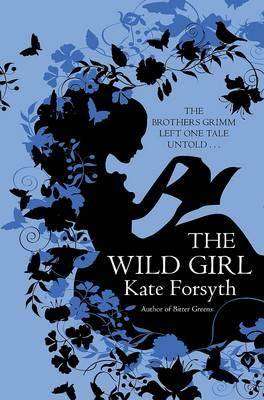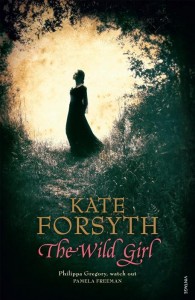Kate Forsyth shares a behind-the-scenes look at The Wild Girl
In celebration of the upcoming UK release of The Wild Girl on 29 July, today I welcome author Kate Forsyth to share with us a behind-the-scenes look at her writing process for this novel.
 I was lucky enough to read The Wild Girl (my review) when it was first released in Australia.
I was lucky enough to read The Wild Girl (my review) when it was first released in Australia.
How beautiful is the UK cover art!
But without further ado, here’s Kate:
I’m not a big fan of prologues.
In fact, I’ve been known to take a writing student’s prologue, scrunch it up into a ball and throw it in the bin in a dramatic gesture to show just how much I hate them. Prologues are normally a great lump of indigestible exposition that delay the connection between protagonist and reader, slow down pace, and make the novel’s beginning a damp squib instead of a great, showy bang of fireworks.
Yet my latest novel THE WILD GIRL begins with a prologue.
I know, I know!
Yet sometimes rules are meant to be broken. Or at least bent a little.
Let me explain why I came to bend this particular rule of mine.
THE WILD GIRL tells the extraordinary untold love story of Wilhelm Grimm and Dortchen Wild, the young woman who told him many of the world’s most famous fairy tales. It was a forbidden romance. Wilhelm was poor, with little prospects. Dortchen (who grew up next door to the Grimm family) was one of five girls and was expected to stay home and care for her parents.
It was a bloody and turbulent time, with Napoleon Bonaparte conquering all of Europe. The small electorate of Hessen-Cassel, where the Grimms and the Wilds lived, was one of the first countries to fall. Living under French occupation, unable to find work, Wilhelm and his elder brother Jakob decided to fill their days by writing down all the old stories which were being forgotten. They hoped the book might be published and so help them earn some money. The brothers were the sole providers for their three younger brothers and their little sister, who was still in her teens. Jakob and Wilhelm began by asking their friends and neighbours if they knew any old stories … and discovered that their sister Lotte’s best friend Dortchen knew many wonderful stories.
As Dortchen tells Wilhelm her stories – haunting, romantic, strange, and dark – they fall in love. Or, at least, Wilhelm falls in love with Dortchen. She has always loved him. She fell in love with him the first time she saw him: ‘She was only twelve years old, but love has never been something that can be constrained by age. It happened in the way of old tales, in an instant, changing everything forever. It was a fork in the path, the turn of a key, the kindling of a lantern.’
I knew that Dortchen had really had a childhood crush on Wilhelm. In one of her few remaining letters, written to Lotte when she was only thirteen years old, Dortchen confessed how she would not mind shaking Wilhelm’s hand, even though she disliked being obliged to shake hands with anyone else.
It was a small stretch to imagine that this girlish crush began at their very first meeting, when she was twelve and he was nineteen. And because THE WILD GIRL is essentially a romance – even if of somewhat epic proportions – the story needed to begin when the romance first began.
 Beginning the story at this first meeting made narrative sense for other reasons too. They met just at the beginning of the Napoleonic Wars in Europe, a time when political tensions were escalating and the world that Dortchen and Wilhelm knew was about to change forever.
Beginning the story at this first meeting made narrative sense for other reasons too. They met just at the beginning of the Napoleonic Wars in Europe, a time when political tensions were escalating and the world that Dortchen and Wilhelm knew was about to change forever.
However, Dortchen was then only twelve. Just a child. I didn’t think it was a good idea to begin an epic romance – a novel filled with thwarted desire and despair – with a child protagonist.
And I also did not want there to be any hint of any sexual attraction between Wilhelm and the pretty girl-next-door until she was a young woman.
So I had to find another scene to open the book. A scene that hooked the reader’s attention, a scene that created suspense and a desire to know what happens, a scene that let the reader know this was a book about love and war, desire and death, betrayal and new beginnings.
A scene describing Dortchen meeting her best friend’s big brother just couldn’t carry all this weight of significance. I had to find a different opening scene.
I worried about this for a long time. I thought about beginning the book at the end, but then the reader would know what happened and the story would lose its slowly building suspense. I thought about starting at the point of crisis and then circling back (a time-honoured narrative structure), but it still did not feel right.
I kept on working away at the novel, building my timeline and my plotline, reading and researching, wondering and worrying. I found myself unable to write (I am someone who likes to begin with my opening scene, and then work in a very logical and linear fashion towards the end). I found myself unable to sleep.
One night I lay awake for many hours, running my story through my mind, agonising over this problem. At last I slipped into sleep, and dreamt the most extraordinarily vivid dream. I saw a young woman in a long black dress, dancing alone in a snowy forest at twilight. She was dancing wildly, laughing and crying at the same time. On a hill above the forest was a castle. Inside people were dancing to violin music, their shadows twirling past the golden-lit windows. But the girl was all alone.
Then out of the shadows stepped a young man dressed all in black. He began to dance with her, and the scene turned to one of joy.
I woke up, my head full of images, and ran through the dark house in my nightie to my study. I wrote the scene as I had dreamed it, except that I split it in two. The first half became the opening scene, my Prologue; the second half became my closing scene, my Epilogue.
These are the opening lines, almost exactly how I wrote them that day:
‘Wild by name and wild by nature,’ Dortchen’s father used to say of her. He did not mean it as a compliment. He thought her headstrong, and so he set himself to tame her.
The day Dortchen Wild’s father died, she went to the forest, winter-bare and snow-frosted, so no one could see her dancing with joy. She went to the place where she had last been truly happy, the grove of old linden trees in the palace garden. Tearing off her black bonnet, she flung it into the tangled twigs, and drew off her gloves, shoving them in her coat pocket. Holding out her bare hands, embracing the cold winter wind, Dortchen spun alone among the linden trees, her black skirts swaying.
Snow lay thick upon the ground. The lake’s edges were slurred with ice. The only colour was the red rosehips in the briar hedge, and the golden windows of the palace. Violin music spilled into the air, and shadows twirled past by the glass panes.
The death of Dortchen’s father happens in the very middle of the book, the key pivotal point, what I call ‘the dark night of the soul’. The midpoint reversal, to give its proper literary term, is always a psychic hinge in a narrative. To begin a story at this point is such a time-honoured narrative decision it has its own Greek term: in media res, which means ‘begin in the middle’.
Yet the answer was given to me by my subconscious, in a dream that still haunts me to this day.
Disclosure: If you click a link in this post we may earn a small commission to help offset our running costs.
Sign up to our Booklover Book Reviews emails and receive our gift for new subscribers. LEARN MORE >>
I am sure you will join me in thanking Kate for this wonderful insight into her storytelling process, and see that if you have not already read The Wild Girl or have plans to do so, you are missing out on something beautifully crafted and extremely memorable.
– – –
- Read my review of Kate’s earlier adult novel, Bitter Greens, one of my Best Books of 2012
- Kate regularly writes book reviews and shares her reading lists and writing advice on her blog.
- Buy The Wild Girl at The Book Depository, Booktopia, Kobobooks, Amazon, B&N
UPDATE: We have reviewed Kate subsequently published novels, The Beast’s Garden and Beauty in Thorns.
